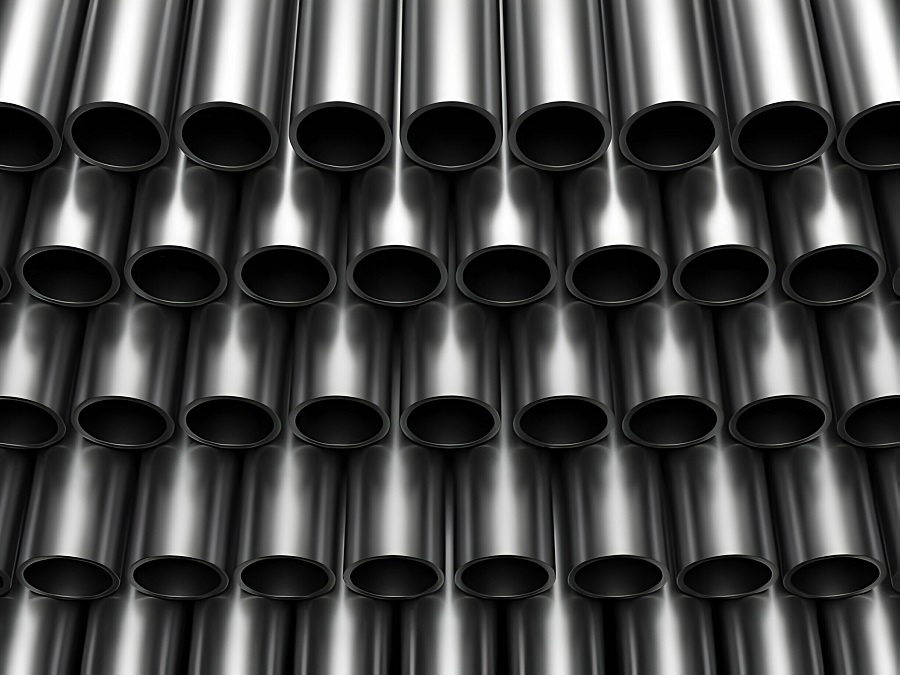Quick Inquiry
Carbon steel seamless tubes are essential components used in various industries for their robustness, durability, and versatility. These tubes are manufactured without any welding seam, ensuring uniform strength and structural integrity, making them ideal for critical applications like heat exchangers, boilers, and pipelines. Choosing the right grade of Carbon steel seamless tubes is paramount to ensuring performance, longevity, and cost-effectiveness in any project. Read on to learn more.

Understanding Carbon Steel Grades
Carbon steel is a blend of iron and carbon. It also contains small amounts of other elements like manganese and silicon. Sometimes, it may also contain sulfur and phosphorus. The carbon content in these tubes significantly influences their properties, determining their suitability for specific applications.
The classification of carbon steel grades is based on their carbon content:
- Low Carbon Steel: Contains up to 0.3% carbon. It offers good ductility, weldability, and toughness, suitable for applications requiring forming and bending.
- Medium Carbon Steel: Contains between 0.3% to 0.6% carbon. This grade provides higher strength and hardness compared to low-carbon steel, making it suitable for applications requiring more load-bearing capacity.
- High Carbon Steel: Contains more than 0.6% carbon. High carbon steel offers excellent hardness and wear resistance but may be less ductile and more challenging to weld.
Alloying elements like manganese, silicon, and others are added to enhance specific properties such as strength, corrosion resistance, and machinability.
Factors Influencing Grade Selection
Several factors should be considered when selecting the appropriate grade of carbon steel seamless tubes:
- Mechanical Properties: The mechanical properties required for the application, including tensile strength, yield strength, hardness, and flexibility, dictate the suitable grade. For instance, heat exchanger tubes require specific strength and thermal conductivity properties.
- Environmental Conditions: Consider the operating environment such as temperature, humidity, and exposure to corrosive elements. Carbon steel grades with added corrosion resistance elements like chromium or nickel may be necessary for certain conditions.
- Weldability and Formability: Depending on the fabrication process and joining methods involved in the project, select a grade that offers good weldability and formability without compromising structural integrity.
- Cost Implications: Different grades of carbon steel come at varying costs due to differences in composition and manufacturing processes. Balancing performance requirements with budget constraints is crucial in selecting the most cost-effective option.
Common Grades of Carbon Steel Seamless Tubes
Overview of Commonly Used Grades
When selecting carbon steel seamless tubes for specific applications such as heat exchangers, it’s essential to consider the appropriate grade that meets the required specifications and performance standards. Here are some commonly used grades known for their reliability and suitability in various industrial sectors:
1. ASTM A106:
ASTM A106 is a standard specification for seamless carbon steel pipes for high-temperature service. This grade of carbon steel seamless tubes is widely used in industries such as oil refineries, power plants, and boilers due to its excellent high-temperature strength and resistance to corrosion. ASTM A106 seamless tubes are available in grades A, B, and C, with varying tensile and yield strength levels.
2. ASTM A53:
ASTM A53 is another widely used standard specification for seamless and welded carbon steel tubes. It is commonly used for general-purpose applications in industries such as plumbing, mechanical, and structural. ASTM A53 seamless tubes are available in three types – Type F (continuous welded), Type E (electric resistance welded), and Type S (seamless).
3. API 5L:
API 5L is a specification for seamless and welded steel pipes suitable for conveying gas, water, and oil in the natural gas and petroleum industries. This standard covers seamless and welded carbon steel pipes, with various grades such as API 5L Grade B and X42 to X70, designed for specific transportation requirements.
4. ASTM A179:
ASTM A179 is specifically designed for seamless cold-drawn low-carbon steel heat exchangers and condenser tubes. These tubes are widely used in industries requiring heat transfer equipment due to their excellent thermal conductivity and corrosion resistance. ASTM A179 seamless tubes are typically used in applications where high heat transfer efficiency is essential, such as in boilers, heat exchangers, and condensers.
Each of these grades has unique properties and characteristics tailored to specific applications. For example, ASTM A106 and API 5L grades are preferred for high-pressure and high-temperature applications in the oil and gas industry, whereas ASTM A179 is ideal for low-pressure and low-temperature heat exchanger applications.
Factors to Consider in Grade Selection for Heat Exchanger Tubes
When selecting carbon steel seamless tubes for heat exchangers, it’s crucial to consider several factors:
- Temperature Resistance: Ensure the selected grade can withstand the operating temperatures of the heat exchanger without compromising structural integrity.
- Corrosion Resistance: Choose a grade with adequate corrosion resistance properties to minimise the risk of degradation over time, especially in environments with moisture or chemical exposure.
- Heat Transfer Efficiency: Opt for a grade that offers high thermal conductivity to maximise heat transfer efficiency and overall performance of the heat exchanger.
- Compliance with Standards: Verify that the selected grade complies with relevant industry standards and specifications to ensure quality and reliability.
Highlight Specific Properties and Applications of Each Grade
Application-Specific Guidelines
Choosing the right grade of carbon steel seamless tubes involves considering specific properties and applications to ensure optimal performance and reliability across various industries. Let’s explore how different grades cater to specific requirements:
1. Oil and Gas Industry Requirements
- ASTM A106 (Grade B/C): This grade is widely used in the oil and gas industry for high-temperature and high-pressure applications such as pipelines, refineries, and processing plants. ASTM A106 Grade B/C seamless tubes offer excellent strength and toughness, making them suitable for conveying fluids and gases under demanding conditions.
- API 5L (Grade B to X70): API 5L seamless tubes are specifically designed for the transportation of oil and natural gas. Different grades within API 5L cater to varying levels of mechanical properties and corrosion resistance, ensuring reliable performance in offshore and onshore installations.
2. Structural Applications
ASTM A53 (Type S/E): ASTM A53 seamless tubes are commonly used in structural applications such as construction, bridges, and buildings due to their versatility and ease of fabrication. Type S and Type E tubes offer excellent weldability and formability, making them ideal for structural frameworks and load-bearing components.
3. Heat Exchangers and Boilers
ASTM A179: ASTM A179 seamless tubes are specifically designed for heat exchangers and condensers, offering exceptional thermal conductivity and corrosion resistance in low-temperature environments. These tubes efficiently transfer heat between fluids, making them ideal for boilers, heat exchangers, and HVAC systems.
4. Automotive and Machinery Components
Low Carbon Steel (e.g., ASTM A333 Grade 6): Low carbon steel seamless tubes like ASTM A333 Grade 6 are commonly used in automotive and machinery applications where ductility, weldability, and impact resistance are essential. These tubes are suitable for components requiring bending, machining, and forming.
5. Pressure Vessel Applications
High-Strength Carbon Steel (e.g., ASTM A106 Grade C): carbon steel seamless tubes with higher carbon content and tensile strength are used in pressure vessel applications where durability and reliability under extreme pressure conditions are critical. ASTM A106 Grade C tubes are suitable for pressure vessels in chemical processing plants and power generation facilities.
Selection Process and Consultation
Importance of Consulting with Material Experts or Engineers
Selecting the right grade of carbon steel seamless tubes involves a comprehensive understanding of application requirements, operating conditions, and material properties. Consulting with experienced material experts or engineers is crucial to ensuring optimal performance and cost-effectiveness in your project. Here’s why their expertise is invaluable:
1. Application Understanding:
Material experts can assess the specific application requirements, such as temperature, pressure, and environmental factors, to recommend the most suitable grade of carbon steel seamless tubes. They consider factors like corrosion resistance, thermal conductivity, and mechanical strength to ensure the chosen grade meets or exceeds performance expectations.
2. Mechanical Properties Evaluation:
Engineers can help evaluate the required mechanical properties, including tensile strength, yield strength, hardness, and ductility, based on the intended use of the seamless tubes. This ensures the selected grade can withstand the stresses and demands of the application without compromising structural integrity.
3. Fabrication Considerations:
Experts can advise on the effects of fabrication processes like welding, bending, and forming on different grades of carbon steel tubes. Certain grades may require specific techniques or post-weld treatments to maintain their properties and performance.
4. Long-Term Performance Assessment:
By considering factors such as service life, maintenance requirements, and potential operational challenges, material experts can recommend grades that offer optimal long-term performance and durability. This proactive approach helps prevent premature failures and unexpected downtime.
Steps to Consider When Selecting the Right Grade
To ensure the selection of the right grade of carbon steel seamless tubes, follow these essential steps:
- Define Application Requirements and Operating Conditions: Clearly define the purpose of the seamless tubes, including operating temperature, pressure, fluid characteristics, and exposure to corrosive environments.
- Evaluate Mechanical Properties Needed: Determine the critical mechanical properties required for the application, such as strength, toughness, and fatigue resistance. Consider the impact of these properties on safety and performance.
- Consider Effects of Fabrication Processes: Factor in the methods and techniques used for fabrication, including welding, bending, and machining. Choose a grade that is compatible with the intended fabrication processes to minimise risks and ensure quality.
- Assess Long-Term Performance and Durability: Look beyond initial requirements and evaluate how the chosen grade will perform over its service life. Consider factors like maintenance needs, operational reliability, and potential for corrosion or degradation.
Consulting with material experts or engineers throughout these steps ensures a comprehensive and informed decision-making process, leading to the selection of the most suitable grade of carbon steel seamless tubes for your specific application.
Quality Assurance and Compliance
When choosing carbon steel tubes, prioritising quality assurance and compliance with industry standards is paramount to ensure safety, reliability, and performance. Here’s why it matters:
- Adhering to Industry Standards and Specifications: Compliance with recognised standards such as ASTM, ASME, and API ensures the seamless tubes meet quality requirements and performance expectations for specific applications.
- Quality Control Measures During Manufacturing and Testing: Quality assurance processes during manufacturing, including raw material inspection, dimensional checks, and non-destructive testing (NDT), guarantee the consistency and integrity of carbon steel seamless tubes.
- Certifications and Regulatory Compliance: Look for manufacturers who provide certifications and documentation verifying adherence to industry standards and regulatory requirements. This includes material certificates, test reports, and compliance statements.
Get Customised High-Quality Carbon Steel Seamless Tubes
Experience the difference with custom carbon steel seamless tubes tailored to your exact specifications. Whether you require tubes for heat exchangers, boilers, pipelines, or structural applications, our expert team is ready to deliver superior quality and performance. Collaborate with Anand Seamless Ltd. to design tubes that meet your unique requirements for strength, durability, corrosion resistance, and more.
Unlock the potential of custom carbon steel seamless tubes engineered to enhance efficiency and reliability in your operations. Contact us at +91-9099996851 or write to us at inquiry@anandseamless.com to discuss your project needs and start the journey towards seamless excellence. Request a consultation and discover how our customised solutions can optimise your industrial processes.
lATEST BLOG |
|
How to Select the Right SA 179 Seamless Tube For Your Project?
Choosing the right SA 179 seamless tube for your p |
|
An Introductory Guide to Understanding Evaporator Tubes
Evaporator tubes are crucial components in various |
|
Guide to Maintaining Steam Coil Heater Tubes in HVAC Systems
Steam coil heater tubes are integral to the effici |
|
Carbon Steel Tubes: Essential Components in Shipbuilding
Selecting the right materials is of utmost importa |
|
How to Choose Right Grade Carbon Steel Seamless Tubes
Carbon steel seamless tubes are essential componen |

